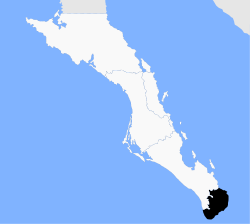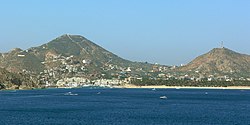Municipio Los Cabos
| Los Cabos | ||
|---|---|---|

|
||
| Symbols | ||
|
||
| Basic data | ||
| Country | Mexico | |
| State | Baja California Sur | |
| Seat | San Jose del Cabo | |
| surface | 3760 km² | |
| Residents | 238,487 (2010) | |
| density | 63.4 inhabitants per km² | |
| founding | 1981 | |
| Website | www.loscabos.gob.mx | |
| INEGI no. | 03008 | |
| politics | ||
| Presidente municipal | Jesús Armida Castro Guzmán | |
| Cabo San Lucas | ||
Coordinates: 23 ° 12 ′ N , 109 ° 42 ′ W
| Los Cabos | ||||||||||||||||||||||||||||||||||||||||||||||||
|---|---|---|---|---|---|---|---|---|---|---|---|---|---|---|---|---|---|---|---|---|---|---|---|---|---|---|---|---|---|---|---|---|---|---|---|---|---|---|---|---|---|---|---|---|---|---|---|---|
| Climate diagram | ||||||||||||||||||||||||||||||||||||||||||||||||
| ||||||||||||||||||||||||||||||||||||||||||||||||
Los Cabos is the southernmost district ( municipio ) of the Mexican state of Baja California Sur . The municipality had 238,487 inhabitants at the 2010 census, the area amounts to 3760 km². The seat of the district administration is San José del Cabo ; another major city in the district is Cabo San Lucas .
geography
The municipality of Los Cabos is one entirely to the physiographic province of the peninsula Baja California , at the southern tip, to the south of the state of Baja California Sur , it is located. It is up to 1800 m altitude. Geologically, the municipality is made up of a good 50% intrusive rock , about 33% sedimentary rock , 9% alluvion and 2.5% extrusive rock , the predominant soil types are the Regosol (51%) and the Leptosol (36%). A good half of the district area is forested, a good 40% is covered by scrub landscape.
The municipality borders in the north and west on the municipality La Paz and in the south and east on the Pacific .
population
According to the 2010 census, the municipality has 238,487 inhabitants in around 65,000 residential units. Of these, 4114 people were registered as speakers of an indigenous language , including 1260 speakers of the Nahuatl and 603 speakers of the Popoloca. About 2.9% of the population were illiterate. 110,085 inhabitants were registered as economically active, of which approx. 66% were men or 6.6% were unemployed. 5.6% of the population lived in extreme poverty.
The district had the highest murder rate per inhabitant in the world in 2017.
Places and structure
The municipality of Los Cabos comprises 549 inhabited localidades , of which the INEGI also classifies Cabo San Lucas, Colonia del Sol, Las Palmas, Las Veredas and San José Viejo as urban in addition to the main town. In the 2010 census, six towns had a population of over 5,000, a further 13 towns had at least 500 inhabitants, and 507 towns had fewer than 100 inhabitants. The largest places in the municipality are:
| place | population |
|---|---|
| San Jose del Cabo | 69,788 |
| Cabo San Lucas | 68,463 |
| Colonia del Sol | 48.032 |
| Las Palmas | 11,562 |
| Las Veredas | 10,478 |
| San José Viejo | 7,222 |
| La Ribera | 2,050 |
| San Bernabé | 1,794 |
| La playa | 1,417 |
| Miraflores | 1,384 |
The district is divided into four delegaciones : Cabo San Lucas, La Ribera, Miraflores and Santiago.
tourism
The most important economic factor of the municipality is tourism. The Los Cabos holiday center is made up of Cabo San Lucas and the seaside resort of San José del Cabo, 32 km further east. There are mainly elegant hotel complexes between the two locations. In the Los Cabos region you will find high mountain ranges, barren sandy deserts, beaches and deep blue ocean. Los Cabos is known for its El Arco rock formations where the Pacific meets the warm waters of the Gulf of California .
literature
- Paul Ganster, Antonina Ivanova, Oscar Arizpe C. (Eds.): Los Cabos: Prospective for a Natural and Tourism Paradise. San Diego State University Press and Institute for Regional Studies of the Californias, San Diego 2013, ISBN 978-1-938537-00-4 .
Web links
- Enciclopedia de los Municipios y Delegaciones de México: Municipio Los Cabos (Spanish)
- INEGI : Datos Geográficos: Municipio Los Cabos (Spanish; PDF)
Individual evidence
- ↑ Highest murder rate worldwide Mexico News Daily , March 8, 2019


